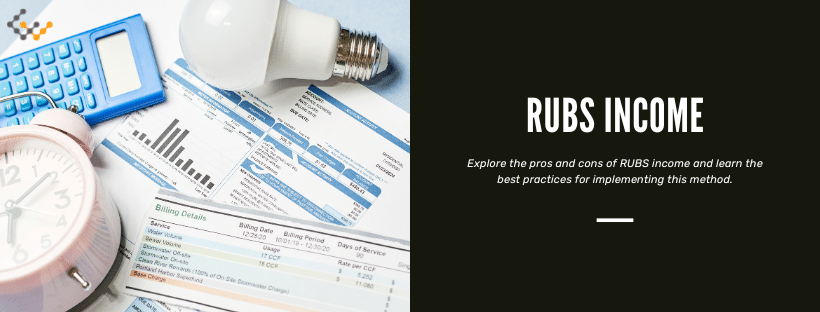Understanding RUBS Income in Commercial Real Estate

Property owners of multifamily or multi-unit commercial real estate must determine the most appropriate way to ensure utilities are paid. One option is to pay all utilities for units and charge some set amount extra to do so. A secondary method involves installing submeters at each unit to charge these costs based on actual use. However, both methods have limitations, so some investors use Ratio Utility Billing System or RUBS.
What Is RUBS Income and How Does It Work?
RUBS is a specific process for calculating the cost of utilities based on the unit’s square footage. It may also use factors such as the number of bathrooms the location has or the number of tenants in multifamily properties.
This calculation method also utilizes information based on the utilities the property uses, such as charging some commercial properties more based on their use of a larger number of appliances or equipment compared to those that do not. Other factors may include considerations for the number of water fixtures the unit has or the power demand.
Answer a few questions and get custom mortgage quotes. We'll match you with offers from our network of 650+ lenders.
The goal is to get more insight into the cost of utilities for the individual property so that the appropriate charge can be applied. This method aims to provide a clear idea of what each unit uses in utilities without having to install meters within each unit, which is often cost-prohibitive if they are not installed during construction.
In order for the RUBS system to be utilized, the investor must provide insight to the tenant at the time of the creation of the contract, and then the tenant must agree to this method. Tenants and landlords should know the methods used to calculate utility usage.
Keep in mind that in some communities, RUBS is not legally allowed to be used. It is dependent on the city’s requirements and code.
Benefits and Drawbacks of RUBS Income
Used in either apartments or commercial property with individual units, RUBS can offer an effective manner for dividing utility costs among tenants.
Advantages for Multifamily Owners and Property Managers
There are some key benefits to using RUBS to calculate utilities over other methods:
- This method reduces costs to the property owner for utilities. If done properly, the tenant pays for all utility costs, and the property owner does not. There is also no cost to the property owner for installing individual meters.
- Some tenants are more conscientious and reduce utility use. Since they must pay for their use, many tenants will reduce their utility use, making them more conservative. By comparison, when they pay a flat fee, they typically use as much as they want without concern over misuse.
- This method can improve the commercial property’s value. It helps to reduce the investor’s utility bills and therefore improves net operating income. When the property is sold later, utilities are not negating profits making the property more attractive to other investors.
Disadvantages for Multifamily Owners and Property Managers
Investors must also consider some potential disadvantages to using this type of scenario:
- Compliance could be a concern. In some situations, filling vacancies can be more difficult when the RUBS method is in place, especially if competitors cover the cost of utilities within their agreement in a more affordable way to the tenant. Existing tenants must also agree to this method, and some may not.
- Tenants may not be as fair as they should be. To be accurate, this method must understand the individual unit’s actual use of utilities, but if one tenant abuses that use, it could raise costs for all units.
- Some housing markets do not allow for the RUBS method. Some require there to be careful, evident-based calculations of the costs charged to ensure it is accurate.
Best Practices for Implementing RUBS Income
To get the most out of the RUBS in real estate, it is critical to ensure the process is done properly. RUBS income refers to the funds the tenant pays to cover utility costs.
Proper implementation is key:
- Determine the total square footage of each unit of the multi-unit properly.
- Determine the existence and number of water fixtures in each unit.
- Determine the number of occupants for that property.
One of the complications here is that each unit will have its own individual calculation to determine the utilities used. This makes the process a bit more complex, but the property owner must ensure it is done properly to pay all costs. If an error occurs, the RUBS income does not cover all of the property’s utility costs, leading to unfair charges.
Ensure legal compliance throughout the process.
- A full property analysis is necessary to get a clear understanding of the costs charged to each tenant.
- Lease addendums must be given to all current residents that outline the new process and methods. It should clearly explain what is occurring and how the costs are calculated.
- Provide billing and unit information into some software or other managed platform to ensure tenants can see what they are being charged. This often will require sharing the master utility bills into the selected system.
- Once the process is set up and all tenants have signed an agreement, the property owner may issue individual utility bills to each renter.
- The tenant will then pay the utility billing company.
It is often necessary to review this information over time. New tenants must also agree to the RUBS method and understand its use. When new tenants onboard, this may lead to fluctuations in costs for all tenants. Careful analysis of this division of costs is necessary over time, making adjustments based on usage changes.
Because of the complexity involved with RUBS, some property management companies outsource the process to a 3rd party Resident Utility Billing provider.
RUBS vs Submetering
The alternative to a property owner that does not want to pay utilities by charging a flat fee to tenants is to use submetering. In this process, the property owner or property management company invests in meters installed at each unit. By placing meters in each unit, there is a way to comprehensively collect data about the amount of utility each unit uses. This then allows the property owner to charge each tenant based on their actual costs.
However, this method is very expensive since installing meters in each unit can be difficult in some buildings. This is especially true for properties that were not built to be multi-unit properties at some point.
Most often, the cost of submetering is prohibitive for most property owners, though it could be the ideal option in some cases. RUBS aims to create the same pay-for-use method but without that added cost.
Wrapping Things Up
RUBS is an effective manner for property owners to charge tenants based on the utilities they use. When done well, this method can help eliminate the owner paying the tenant’s utility costs and may help alleviate some cash flow limitations while also boosting net income. However, it requires careful organization and agreement of all tenants to ensure it is done fairly. This often means understanding the tenants and their use of utilities over a period of time.

